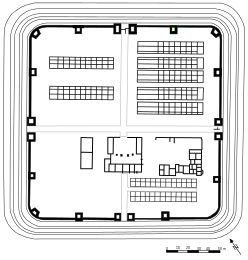Arcobara (castra)
| Arcobara | |
|---|---|
|
The plan of castra. | |
 Location within Romania | |
| Known also as | |
| Founded | 2nd century AD |
| Place in the Roman world | |
| Province | Dacia |
| Administrative unit | Dacia Porolissensis |
| Administrative unit | Dacia Superior |
| Limes | Porolissensis |
| Directly connected to | |
| Structure | |
| — Stone structure — | |
| Size and area | 182 m x 182 m (3.3 ha) |
| — Wood and earth structure — | |
| Size and area | 140 m x 135 m (1.8 ha) |
| Stationed military units | |
| — Legions — | |
| — Cohorts — | |
| II Britannica [3] | |
| — Alae — | |
| I Tungrorum Frontoniana [4] | |
| Location | |
| Coordinates | 47°12′38″N 24°05′43″E / 47.210528°N 24.095361°E |
| Altitude | 267 m (876 ft) |
| Place name | Platoul Măgura |
| Town | Ilișua |
| County | Bistrița-Năsăud |
| Country |
|
| Reference | |
| RO-LMI | BN-I-s-A-01354[1] |
| RO-RAN | 35303.02[2] |
| Site notes | |
| Recognition |
|
| Condition | Ruined |
| Excavation dates | |
| Archaeologists | |
Arcobara [7] (previously identified as Arcobadara [8][9][10]) was a fort in the Roman province of Dacia in the 2nd and 3rd centuries AD.[2] It was unearthed in the village Ilişua (commune Uriu, Romania) in 1978.[2] The fort was edified by Ala I Tungrorum Frontoniana.[11] On the site a significant number of ballista projectiles were discovered: 27 stone projectiles having diameter between 7 to 13.5 cm and weigh up to 2 kg.[12] The artillery was used as defensive, probably located in the fort's towers.[12] These artifacts indicates the presence of ballistarii in this fort.[12]
See also
External links
Notes
- ↑ 1.0 1.1 "Lista Monumentelor Istorice 2010 ("2010 List of Historic Monuments")" (PDF). Monitorul Oficial al României, Partea I, Nr. 670 ("Romania's Official Journal, Part I, Nr. 670"), page 472. Ministerul Culturii şi Patrimoniului Naţional. 1 October 2010. Archived from the original (PDF) on 10 June 2012. Retrieved 4 January 2013.
- ↑ 2.0 2.1 2.2 2.3 2.4 "Situl arheologic de la Ilişua - Vicinal". National Archaeological Record of Romania (RAN). ran.cimec.ro. 2012-07-22. Retrieved 4 January 2013.
- ↑ 3.0 3.1 "Ilisua". Strateg Maps. http://www.net4u.ro. Retrieved 4 January 2013.
- ↑ Adrian Bejan: DACIA FELIX - Istoria Daciei romane, Timișoara, 1998
- ↑ 5.0 5.1 5.2 Corneliu Gaiu, Radu Zăgreanu: "Inscripţii şi piese sculpturale din castrul roman de la Ilişua", Ed. Accent, Cluj-Napoca, 2012
- ↑ 6.0 6.1 Bibliografia lucrărilor științifice ale membrilor Institutului de Istorie din Cluj (1920-2005)
- ↑ Dana, Dan; Gaiu, Radu; Zăgreanu, Radu (2012). "Un nou duplicarius din ala I Tungrorum Frontoniana atestat pe un vas descoperit în castrul roman de la Arcobara/Ilișua". p. 56. Retrieved January 14, 2014.
- ↑ Nemeti, Sorin; Bărbulescu, Mihai (2010). "Arcobadara". p. 11. Retrieved 2013-05-26.
- ↑ Cristian Găzdac, Corneliu Gaiu, Elena Marchiş: "Arcobadara (Ilişua)", Ed. Mega Publishing House, Cluj-Napoca, 2011
- ↑ bistrita24 (2011-03-24). "Intâlnire cu lumea romană ("Meeting with the Roman world")". bistrita24.ro - la zi. http://bistrita24.ro. Retrieved 4 January 2013.
- ↑ Nemeti, Sorin. "Piese de bronz roman de la Ilișua ("Roman bronze pieces from Ilişua")". Retrieved September 29, 2013.
- ↑ 12.0 12.1 12.2 Zăgreanu, Radu (2013). "Proiectile de piatră din castrul roman de la Arcobadara". Revista Bistriței. Editura Accent. p. 9. Retrieved April 10, 2014.
Coordinates: 47°12′34″N 24°08′24″E / 47.20944°N 24.14000°E
| ||||||||||||||
